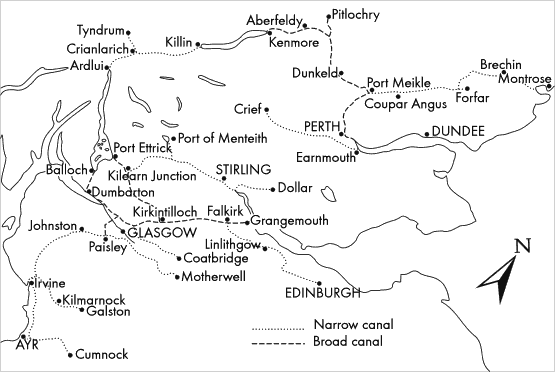The Clyde and Tay Canal.
After the completion of the Forth and Clyde Canal in 1757, canal mania gripped Scotland. It was during this period of euphoria that the ambitious Clyde and Tay canal was proposed and built.

The Canals of Scotland. Central Scotland was crossed by a network of canals
In May 1768 James Murray was commissioned to survey a canal from the lead mines of Tyndrum to Loch Lomond. The Earl of Breadlalbane who suggested the plan, to open a passage into his land for the transport of coal and other goods. Murray reported that a 25 ft wide and 3 foot deep canal could be constructed for £25,000. The scheme involved 68 locks in Glen Falloch to raise the canal to a summit of 598 feet. From which the canal would remain on the same level in Strath Fillan to a port to be built where the river Coninish joined the Fillan.
Considerable correspondence was entered into in the press over the proposal. Including a number of suggestions to continue the line of the canal into Glen Dochart and from there into Loch Tay.
The extension to Murray’s plan was surveyed by James Watt, who proposed a 23 lock canal from the level in Strath Fillan to a harbour that would be constructed at Kilin. He also surveyed a proposal to move the Tyndrum terminus of the canal nearer to Tyndrum and the lead mines there. Further surveys were carried out by Murray to improving navigation on the Tay so that trade through the canal might reach Perth and Dundee. The total cost for the waterway was estimated at £65,000.
On the 24th of April 1771 the Clyde and Tay Canal Bill was passed authorising the construction of the Canal. The subscription for £65,000 was quickly made by Glasgow Merchants and by those in Dundee and Perth.
James Murray was employed as the chief consulting engineer on the canal and, Gordon Hunter, and Anders Reid as local engineers. Work on the canal began on the section from Tyndrum to Loch Lomond and from Perth to Loch Tay.
By the end of 1772 navigation had been established to Loch Tay and the Strath Fillan section had been constructed. The placing of Port Coninish, following Murray’s original plan. Early work on the canal in Glen Falloch was proving difficult, the cost of carving the locks from the rock of the side of the glen caused the cost of the project to escalate rapidly. Murray re-estimated the cost of the construction of the Glen Falloch section at £30,000. The canal company was authorised to raise the money in shares of £50 each. The Tyndrum Lead Mines Company insisted that this section of the canal take precedence over the Glen Dochart. Allowing coal from the Kilsyth mines to reach the company by way of Port Ettrick on the Forth and Clyde Canal. So the initial work on the Glen Dochart section of the canal was halted.
On 22nd August 1775 the Glen Falloch section was completed. 64 locks, including 3 staircase sections one of 12 locks made the 14 miles of canal. There were five large aqueducts and several smaller ones. The Glen Falloch canal is undoubtedly the most ambitious canal project attempted anywhere in the British Isles. In addition to the limitations imposed by so many locks, several sections of the completed cut were only wide enough to permit one barge at a time, further reducing the amount of traffic that could use the Glen Falloch section.
On July 15th the following year, the Glen Dochart section of the canal was completed, allowing goods from the Clyde to reach the Tay.
The initial profits from the canal were a disappointing £1,528. So no dividends could be paid by the canal company which was £11,000 in debt. However the growth of the milling industry along the Tay and the completion of a branch of the canal to Pitlochry saw the profit on the canal rise to £4,384 by 1790. The true value of the canal was proved by the famine of 1783 and 1784, when harvests in Scotland failed, and Baltic grain was imported through the canal.
In 1822 the Tay navigation was extensively improved to allow boats of up to 60 tons into Loch Tay. The Glen Falloch section continued to cause problems to the canal company. It was proposed that a series of cuts connected by boat lifts be built to allow boats to navigate the section more quickly, but the cost of £87,000 was deamed to be to expensive for the level of traffic in the canal. The section was instead extensively rebuilt in 1835, widening the narrow sections and creating a number of basins to ease the congestion in the cut.
Traffic remained slow on the section, and in 1849 the Tyndrum and Ardlui railway was built by the canal company. A breach of the section three years later was never repaired, which closed the navigation in Glen Falloch. In 1856 the Glen Dochart section of the canal closed, with the completion of a branch of the railway to Kilin. Which later became part of the Glasgow and Western Railway.
The Loch Tay Canal, remained open until the nationalisation of the railways in 1940s removed all freight traffic on it. The majority of the navigation is intact and there is a growing campaign to restore it for pleasure craft. The Glen Falloch and Glen Dochart sections of the canal are now dry, and badly eroded by the floods that can pour off the mountains they are built along. There is little chance now that they will ever be restored. The scars of the many locks in Glen Falloch are a fitting industrial memorial to what was a most ambitious canal.
Lewis' main page | Alternative history index | Scottish Guina index